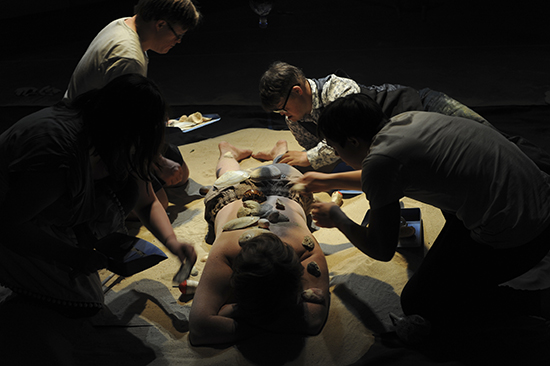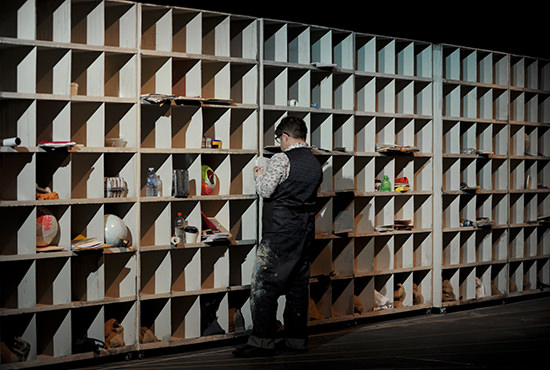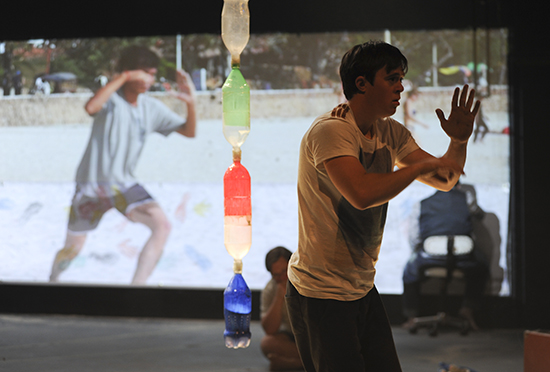RUCKUS tames Time
Keith Gallasch: RUCKUS, Speed of Life

Speed of Life, Ruckus
photo Heidrun Löhr
Speed of Life, Ruckus
We watch tropical landscapes, sunsets and waterways, hear birdcalls and the buzz of mosquitoes, but calm surrenders to quick-fire archival images from the mid 20th century onwards on two 60-degree angled wide screens tracing war, protest and key events (like Prime Minister Gough Whitlam’s returning of Gurindji land to Vincent Lingiari in 1975) but also including footage of Pol Pot and the victims of the killing fields. RUCKUS, a Sydney-based disability-led contemporary performance ensemble, visited those fields when in-residence this year with Epic Encounters, a Cambodian company of principally hearing-impaired dancers. The weight and speed of history as well as the pace of the everyday are writ large in this ambitious production.
In the first part of Speed of Life, we feel the familiar, stressful pace of contemporary life escalating almost out of control as the performers work at vast banks of moveable pigeonhole cabinets designed by Kate Shanahan and eerily lit by Fausto Brusamolino. Wheeling in great circles to a pounding score (Peter Kennard), the workers manically empty the contents across the floor. The long disturbance is counterpointed with seductive video (Martin Fox) of a boy relaxedly and happily swimming underwater, evoking a very different sense of daydreaming time before a belligerent boss appears and berates his charges. Everyone literally hits the wall while images of Pol Pot flicker behind.
Recurrent phone calls interrupt the action. “Is it you, Rachel?” the performers ask, but the caller won’t identify herself, limiting her utterances gnomically to the likes of “I need to slow down so I can think about love.” There are other motifs, some built around traces—outlines of hands and bodies and plaster casts of the feet of several audience members. Performer-visual artist Digby Webster creates a complete work across one of the screens at his own pace while action proceeds elsewhere. These unhurried actions open out time leaving behind the workplace mayhem and grim politics of the first part of the work to engender a vision which is palpably artistic and cosmological.
Onscreen, a Cambodian man dances subtly and eloquently on a beach; on stage Chris Bunton informally mirrors him, moving with grace and spirit. The sole female performer, Audrey O’Connor, breaks from her role as documentary-maker to dance a circle around the stage. As a cone of sand is levelled and carefully raked, James Penny declares, “I’m becoming The Sandman,” spins dizzily, sinks into the sand and is cocooned in it by the others. It’s an escape from time or into some unhurried transcendent time, an image at once serene and funereal but, above all, one that encourages taking time out for reflection and release.

Speed of Life, Ruckus
photo Heidrun Löhr
Speed of Life, Ruckus
There are moments of telling humour—in a drolly funny exchange about sweeping, mopping and workplace dignity at Maccas, Gerard O’Dwyer and James Penny reveal the challenges of communication, in particular the time taken to react and to playfully embrace the rhythms of conversation.
A brief video appearance at the show’s end by the mystery caller brings home the importance of the show’s theme. Rachel Sugrim provided text and key ideas for the show, especially its poetic finale, but the speed of the production process apparently proved too challenging for her.
The time theme emerged from these performers’ lives. O’Dwyer decries how speed tongue-ties him—“the words won’t come.” But he comes to believe “it’s time to be heard; to breathe!” O’Connor’s mother’s fear that her child “won’t be able to keep up” is recalled. Her daughter is now able to say of her, “You’re proud that you were wrong.” This is not about the overheated time of the everyday, but the long-term time of development and maturation and its distinctive pressures.
It would have been interesting to understand what other temporal impediments impinge on the lives of these performers, but the creators principally opted to create a generalised workplace scenario in the first part of the work with everyone under the same pressure. However, a subsequent Q&A revealed that the pigeonhole cabinets reflected Digby Webster’s experience of working in a mailroom.
Set against a background of the turbulent rush of history and juxtaposed with a sinuous time-defying Cambodian dancer, Speed of Life’s transition from fraught labour to artistic freedom and philosophical reflection was magical. Although some sequences were dauntingly repetitive and over-determined and some images elusive, Speed of Life was admirably well-produced by a large team of collaborators fronted by utterly confident performers who engaged us with commitment, artistry and intelligence. For those of us without disabilities who struggle with time, we now know how much more difficult it is for others. But we also know they’re dealing with it.

Speed of Life, Ruckus
photo Heidrun Löhr
Speed of Life, Ruckus
Ruckus, Speed of Life, co-director, choreographer Dean Walsh, co-director, producer Alison Richardson, performers Chris Bunton, Audrey O’Connor, Gerard O’Dwyer, James Penny, Digby Webster, Rachel Sugrim, set, costume design Kate Shanahan, sound design Peter Kennard, video design Martin Fox, lighting design Fausto Brusamolino; PACT, Erskineville, Sydney, 25-28 May
RealTime issue #133 June-July 2016






